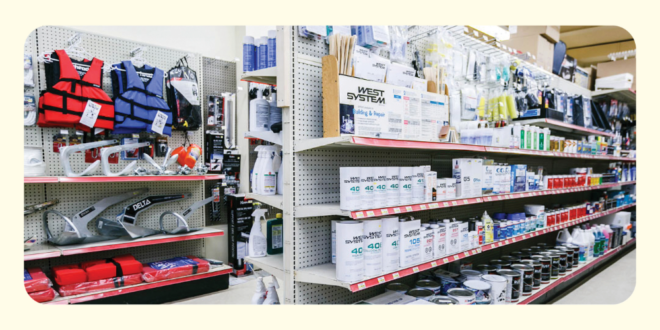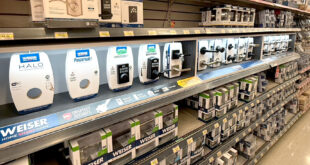The core categories in a home improvement store—such as electrical, plumbing and paint—might be the cash cows for most retailers, but diving into niche categories can also add to the bottom line. Adding niche categories is also an excellent way to cater to your customers’ wants and differentiate yourself from the competition. As you consider what niches best suit your operation, see how these retailers found success in five niche categories.
1. Marine and Boating
Situated near Lake Simcoe in Barrie, Ontario, Robinson Home Hardware has been serving customers with a robust marine and boating category.
Jim Robinson, who owns the store with his brother John Robinson, says the store has two 20-foot aisles of
marine and boating products.
“It’s not one of our biggest categories, but it certainly pulls its weight,” Robinson says.
While the store has been in business for over 100 years, it didn’t start carrying marine and boating products until
about 40 years ago. Robinson says the previous location of the store backed up to the town dock, which was the catalyst for adding this niche. The store moved to a more residential location five years after they added the marine and boating category, but it has remained a strong department even after moving away from the water. Robinson is also a boater, so he’s familiar with the products customers want in this category and can provide insights into what boaters need.
The store carries mostly boat maintenance products and accessories, including cleaning products, marine paints,
epoxies, fiberglass cloths and resins, dock lines, boat hardware, life jackets and rope by the foot. Robinson Home Hardware also offers special ordering for larger, big-ticket items like boat refrigerators.
Boating in that part of Canada is seasonal, and Robinson says the store sees slower sales from September through February, made up mostly of customers looking for products to winterize their boats.
“It’s funny how quick the turnaround between seasons is though,” Robinson says. “When the Toronto International Boat Show opens at the end of January, people start getting excited about the boating season for spring, and we start getting busy selling boating and marine products.”
Despite the slower winter sales, Robinson still keeps all the boating products merchandised all yearlong, just
in a compressed space to make room for other seasonal hardware items customers want during the winter months.
“It doesn’t stay compressed very long, because we have a lot of suppliers we work with who offer early pricing for the coming year, so we start having product roll in the door in January,” Robinson says.
When it comes to promoting the store’s marine and boating category, Robinson says they rely mainly on advertising they are already doing through Home Hardware. He also purchases additional radio advertising in the spring, going beyond their usual advertising radius, as the store attracts customers for marine and boating products from an hour away.
“This is a specialized department with a limited audience, but because of our selection, we get customers coming in from all over,” Robinson says. “Those customers who come in the store for our marine products often aren’t our regular neighborhood customers, so the department has been a great way to bring in a few fresh faces.”
Checkouts: Maryland Retailer Takes Part in Boat Shrinkwrap Recycling Program
In an effort to support conservation efforts and provide a helpful service to customers, Rommel’s Ace located in
Stevensville, Maryland, has joined the Queen Anne’s County Boat Shrinkwrap Recycling Program.
The Chesapeake Bay area is popular for boating and many owners store their boats on land during the winter
months, keeping them safe from the winter weather with winterizing shrinkwrap. Rather than tons of plastic
shrinkwrap ending up in landfills, the program provides a way for boat owners to recycle the shrinkwrap used
for boat winterization.
Stevensville store manager Kellie Barker says she was approached by Sara Shelley, executive director of Plastic Free QAC, asking if the store would provide the recycling bags to customers, which are free for residents of Queen Anne’s County.
“We thought it was a great idea and an easy way to provide an extra service to our customers,” Barker says. “Plastic Free QAC supplied signage, literature and directions on processing of shrinkwrap, making it easy for us.”
2. Furniture and Appliances
When Lisa and Gary Kruse bought their hardware store in 1990 in Hartington, Nebraska, Gary brought numerous years of experience in appliance sales and service and heating and air conditioning service and repair to the business. Since taking over the store, which was selling a few appliances, the Kruses rebranded to Kruse True Value and have added other brands like Maytag, Whirlpool, Amana and KitchenAid, as well as TVs.
Along with product selection, Lisa says the store has found success in this category because the store is an authorized service center that provides service after the sale.
“We deliver and install appliances and TVs, and we also do Dish Network installs in addition to the TV sales,” Lisa says. “Being able to repair appliances is a great selling point.”
Merchandising is also key. Lisa says they have dedicated around 820 square feet to appliances, with 84 pieces on
the salesfloor, including refrigerators, ranges, dishwashers, microwaves, freezers, washers and dryers.
“You need to have a larger area to display appliances on the floor,” Lisa says. “We also have a website that shows
our complete line of appliances, so if customers are wanting something we don’t have on the floor, we can add it to our order. We do a lot of new houses, remodel constructions and custom packages and order and get shipments twice a week.”
Appliances is a year-round category for Kruse True Value, with duress purchases—when the appliances break down and can’t be repaired—making up the largest percentage of sales. Thanksgiving and Black Friday is the busiest time of year, accounting for 35% of sales, with higher sales volumes during Labor Day, Memorial Day and 4th of July.
“Throughout the rest of the year, we advertise through Google searches and utilize a digital marketing company,
AVB Marketing, for advertising,” Lisa says.
Gaining Local Market Share
At Gow’s Home Hardware & Furniture in Bridgewater, Nova Scotia, owner Amanda Fancy says the store began
carrying furniture and appliances in 2019, when the store moved to a new location and amalgamated with a local
furniture business.
“They were looking to sell and retire, and we were looking to grow and build a new store,” Fancy says. “We knew there was a huge opportunity in this category because locally there wasn’t a lot of competition. We knew we would drive a lot of foot traffic from the hardware side of the business, which would ultimately increase the
furniture and appliance business.”
Another reason Fancy decided to expand into this category was market share, as she knew by having a fresh
new location and a strong social media presence, the store could draw more customers and keep them shopping
locally in this category.
“These days it’s very hard to identify product categories with such growth potential such as furniture and
appliances,” Fancy says. “It still is a huge opportunity for us in our current store. It continues to grow, and we
continue to pivot as needed to come up with new lines to bring our customers in the front door.”
To remain successful, Fancy says they will continue to listen to their customers, taking their feedback seriously. She is also always looking for new ways to get products in front of customers.
“We watch what our competitors are doing and always try to provide the extra level of customer service that our customers today are not necessarily used to, which will always give us an advantage over our competition,”
Fancy says.
Like Kruse True Value, merchandising also plays a key role to be successful in this category, Fancy says.
“We merchandise to tell a story. It’s very important to make the space inviting, so the customer feels like they’re
in their own living room if they’re buying furniture or can picture the appliances in their kitchen if they’re buying
appliances,” Fancy says. “By merchandising in this way, we feel it gives us an advantage over our competition and increases the basket size of our customers.”
Finishing Touches: Add on Products to Boost Sales in Your Furniture and Appliance Department
Stage your furniture and appliance section to make the space inviting and help customers envision the pieces in their own spaces. Cross-merchandise the following items from your housewares department to help customers complete the look.
- Lamps
- Throws and blankets
- Pillows
- Candles
- Picture frames
- Kitchen towels
- Plants
- Artwork
3. Automotive Products
Automotive products may not be the first category that comes to mind when customers think about their local hardware store, but for McKeithen’s True Value Hardware in Statesboro, Georgia, it’s a valuable
niche category, driving consistent traffic and adding significant value to the business.
Owner Tom McKeithen has turned this category into a reliable source of sales by carefully curating his product selection and giving automotive a prominent spot in his store.
“Customers come in looking for specific towing accessories, and because we’re now one of the few places offering them, it’s been a steady source of revenue.” —Tom McKeithen, McKeithen’s True Value Hardware
Strategic Merchandising and Expansion
McKeithen’s automotive section occupies about 35 feet of shelf space, but it wasn’t always a large presence in
his store. Initially, automotive products were housed toward the back, near the hand and power tools. As McKeithen expanded his store’s power tool selection, he found himself needing to rework the layout, ultimately
moving the automotive section closer to the front.
“It made sense at first to have automotive near hand tools, but the demand for more power tools meant we had to rethink the layout,” McKeithen says. “Moving automotive to the front gave it more visibility, and the increase in sales reflected that.”
Today, the automotive section is located near the store entrance, positioned as the second main area along the front wall, which ensures it gets noticed by both regular and new customers.
Diverse Product Offerings
McKeithen has curated this niche by stocking an array of essential items, including cleaning products, engine oils, brake cleaners, gas cans, pre-mixed fuel for outdoor power equipment and WD-40.
After a local RV supply business shuttered its doors, McKeithen capitalized on the need in his community for those products and started offering various trailer hitches, wiring for trailers and towing accessories.
“Customers come in looking for specific towing accessories, and because we’re now one of the few places offering them, it’s been a steady source of revenue,” McKeithen says.
Additionally, the McKeithen’s automotive category features 4 feet of products dedicated to RVs, an area McKeithen sees potential to expand further.
Add-On Services
Five years ago, McKeithen took his automotive offerings a step further by introducing electronic car key cutting, a service that’s attracted significant foot traffic.
“Even though there are multiple automotive chain stores in our area, we find a lot of customers coming in for our
electronic keys,” McKeithen says. Adding this service required upfront training. McKeithen and his staff learned how to program the keys and use the cutting equipment through hands-on demonstrations from a company representative, video tutorials and trial and error.
“There was definitely a learning curve with the key cutting, but once we got the hang of it, it became a popular
service,” McKeithen says.
Strategic Partnerships
Statesboro is a college town, and McKeithen’s store is located two miles from Georgia Southern University, making his store one of the closest options for students moving in and out of town. The partnership with U-Haul not only helps him sell related automotive products like trailer hitches and wiring, but it also drives additional
foot traffic from students and residents alike who visit for moving supplies and vehicle rentals.
“I’d recommend any hardware store in a college town consider becoming a U-Haul location,” McKeithen says.
“It’s an easy setup, but you need to be prepared to adjust staffing levels and have enough space to store the vehicles.”
Drive Extra Sales With Add-On Automotive Products
Stocking add-on products in the aisle and near the register for customers already purchasing automotive products can help snatch extra sales.
- Regional Decor
- Stock officially licensed products that support your favorite local professional or high school sports teams.
- Air Fresheners
- Car air fresheners are an inexpensive and easy product to stock around your store. With diverse options like sprays, plug-ins and gels, air fresheners can be cross-promoted with detailing supplies.
- Phone Mount
- With hands-free driving being a law in the U.S., having a mount for your phone allows drivers to utilize their directions from their phone without having to hold their phones, making driving safer. Phone mounts from various brands fit every phone available and can be mounted to vents, dashboards and windshields.
- Tire Repair Kits
- Simple, yet necessary, tire repair kits are products nobody wants to have to buy but will eventually need. Tire repair kits are made for all types of vehicles and are generally inexpensive. Stocking these near your automotive section or by the cash register can encourage impulse buys.
4. Sporting Goods
One major key to finding success in the sporting goods category is curating your selection to the needs and wants of your customers.
Ouray Hardware & Mercantile and Granby Ace Hardware are both located in outdoor adventure hotspots, and capitalized on their locations by expanding into sporting goods. By stocking camping essentials, outdoor gear and seasonal items that appeal to tourists and locals alike, these stores have transformed themselves into destinations for both adventure and hardware needs and turned sporadic foot traffic into loyal customers.
Understand the Local Market
Ouray, Colorado, is a year-round outdoor adventure destination, which puts Ouray Hardware & Mercantile in a
prime location to sell sporting goods to locals and visitors.
Owner Brad Clark opened the store with his wife Carol in 2011 and almost immediately, he knew he couldn’t operate like a traditional hardware store.
When the store first opened, Clark followed the standard merchandising provided by his wholesaler, placing items like drill bits and hand tools near the front. However, this approach wasn’t attracting customers and worse, not attracting tourists, who are a major part of the local economy.
“Our store is located on the main corner in town, and I would stand by our front doors and hear people say, ‘Oh it’s just a hardware store,’ without ever coming in,” Clark says.
After observing low foot traffic for the first season, Clark decided to move his sporting goods and camping gear to the front of the store—and it paid off.
The new displays quickly grabbed the attention of tourists, helping transform the store into a sporting goods and hardware destination in the mountains.
Ouray is also the “Jeep Capital of the World,” boasting over 500 miles of rugged trails, making it a hot spot for 4-wheel driving and camping. So, Clark began stocking and showcasing
products catered specifically to Jeep owners and campers.
“We began offering more camping gear like tents and sleeping mats, but we stayed out of the high-end market so we don’t have to compete with the camping store down the street,” Clark says.
By moving camping essentials—like fishing poles, tents and fire pits—to the front of the store, he was able to capture the attention of tourists passing by.
In addition to outdoor gear, Ouray Hardware stocks seasonal items like hand warmers, gloves and wool socks
during the winter months, ensuring their product mix aligns with the changing needs of the community.
Expand Your Target Audience
Located on the main thoroughfare through town, Granby Ace Hardware caters its product selection and advertising to tourists. Granby, Colorado, has a population of around 2,000 full-time residents, with many homeowners in the area only living in the area seasonally.
The town is nestled between Rocky Mountain National Park and multiple ski resorts, so tourists make up a large percentage of their customers, says Amy Kaplanis, president of Granby Ace Hardware.
“Over the course of 20 years, we’ve grown from an 8,000-square-foot store that only carried
hardware into an 18,500-square-foot store that not only has core hardware, but anything else you need for Grand County living,” Kaplanis says.
The sporting goods category at Granby Ace Hardware has everything visitors would need if they forget or lose important items during their travels in the area.
“We developed our sporting goods to not be something like you would see in another store,”
Kaplanis says. “We have sleeping bags and tents, which are things you wouldn’t think you’d forget to bring on a trip, but people tend to forget these items. We’ve tailored our sporting goods section to serve those needs.”
Sporting goods at Granby Ace Hardware is just as important to overall sales as its core categories. After a recent expansion, Kaplanis was able to expand the store’s sporting goods category.
“If you’re going to get these types of customers in your store, think about what else you can sell them,” Kaplanis says. “There’s hundreds of sales opportunities if you can get them into your store.”
3 Ways to Reel in Sporting Goods Sales
Even if your store isn’t near a national park or in an area where tourists visit to have an adventurous vacation, offering a sporting goods category can drive seasonal sales and impulse purchases for a wide customer demographic.
- Narrow Your Selection
- Trust your numbers. Bringing in new items can be costly, so it’s a good idea to sell the products that make you money and that your customers are buying. If you don’t want to take up a lot of space or if you’re trying out a new vendor, go for the best sellers with the most universal appeal first instead of offering a wider selection.
- Focus on Impulse
- For the most effective impulse displays, focus on seasonal sellers, such as tumblers, coolers or pool toys. Also look for unique items that are low-cost with a wide appeal.
- Visit Specialty Shows
- If you want to make a larger entrance into sporting goods, visit a specialty show with vendors specific
to that category. That’s generally where you’ll find the widest selection and best advice.
- If you want to make a larger entrance into sporting goods, visit a specialty show with vendors specific
5. Pet Products
From puppies to parakeets, cats to chameleons, gerbils to goldfish, we love our pets. A look at anyone’s social
media feed proves how devoted we are to our animal companions, but the numbers speak loudly as well. The American Pet Products Association found pet owners spent $147 billion on pet-related products in 2023. The organization predicts sales for 2024 will be $150.6 billion, growing 3% from 2023.
It can be daunting for home improvement retailers to compete with specialty pet stores and online retailers, but
there is a place for your operation in this lucrative category.
Start With the Basics
Since it opened in 1988, Franklin Hardware and Pet in Chambersburg, Pennsylvania, has been carrying pet
products. Assistant manager Lindsay Deaven says the store owners saw an opportunity to provide local farmers with supplies for not only their farm animals but also their pets.
“The store opened to complement the already existing Franklin Feed and Supply Co.,” Deaven says. “What began
as a store with 9,000 square feet of space has morphed into 30,000 square feet of space for lawn and garden, hardware and anything pet under the sun.”
Of that 30,000 square feet, around 10,000 square feet is dedicated to products for pets, wildlife and livestock.
Franklin Hardware also has sections for live small animals, domestic birds, reptiles and fish.
Franklin Hardware’s pet department didn’t evolve overnight; it has been a labor of love building it to the
size and scope it is today. Retailers looking to get into pet products should start simple, Deaven says.
Deaven suggests launching a pet product section with dog and cat food, carrying brands that are in the middle
of the road in price and already have brand recognition with customers.
She also recommends carrying core items pet owners need like puppy pads, cat litter, treats and collars.
“High-turn dog foods with brand recognition get people in the door, and I think a small animal section
is key,” Deaven says. “Toys for small animals and treats have a high margin and are a good way to balance the
low margins of dog and cat food.”
Equip Your Employees
With its large selection and variety of pet products, it’s important for Franklin Hardware to employ workers
who can educate customers on the different products. Hiring employees who share a love for pets is also
helpful for building relationships and trust with their pet-loving customers.
Deaven leads employee training on new products and trends, utilizing sessions offered by pet product
manufacturers. She also recommends using these companies as resources when starting out in the pet
product business, as most are willing to send retailers planograms and provide staff who can help with product
merchandising in your store.
“Most of the major brands have really good people working for them who are willing to give you help,”
Deaven says. “You can tell them you have 3 feet of space, and they will tell you what products you need in
that space.”
3 Reasons to Welcome Pets Into Your Retail Store
Going beyond stocking its shelves with pet products, Strosniders Hardware has welcomed furry friends into its stores. Strosniders, which has three locations in Maryland, has allowed customers to bring pets into its locations for about 15 years, a policy that has boosted customer relations. Here are three reasons to welcome pets into your store.
- Connect with your customers.
- Claire Peterson, marketing and events manager for Strosniders, says the stores’ owners saw how
much their customers were invested in their furry friends and decided to welcome pets to provide a top-notch experience. “It’s been less about increasing sales and more about connecting
with our customers,” she says. “We love seeing their pets in the stores just as much as they love
bringing them in.”
- Claire Peterson, marketing and events manager for Strosniders, says the stores’ owners saw how
- Offer extra convenience.
- Chuck Kelley, pet buyer for the company’s Bethesda location, says customers appreciate the convenience of being able to bring their pet along to the hardware store to shop. “Our customers love that they can get two things done at once—walk their dog and complete their errands,” he says. “We can tell the pets enjoy coming in the stores.”
- Engage on social media.
- Pets that visit the stores even have their own hashtag, #PetsofStrosniders. The social media campaign started to spread awareness that the stores are pet-friendly, Peterson says, and has been a fun way to
interact with customers online. “It’s garnered nothing but positive engagement from the community, and we plan on continuing with it indefinitely,” she says.
- Pets that visit the stores even have their own hashtag, #PetsofStrosniders. The social media campaign started to spread awareness that the stores are pet-friendly, Peterson says, and has been a fun way to
 Hardware Retailing The Industry's Source for Insights and Information
Hardware Retailing The Industry's Source for Insights and Information






